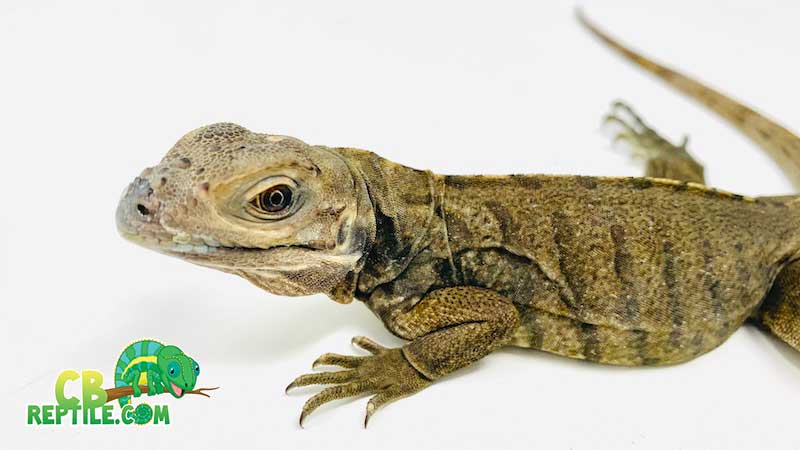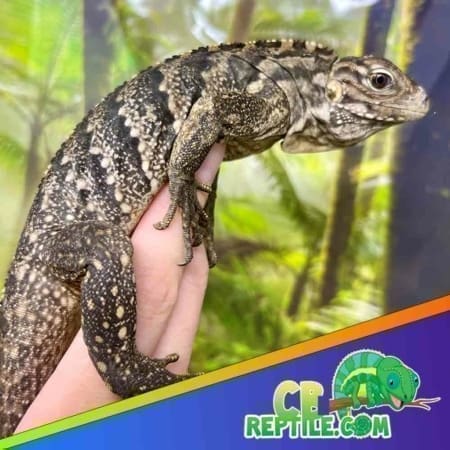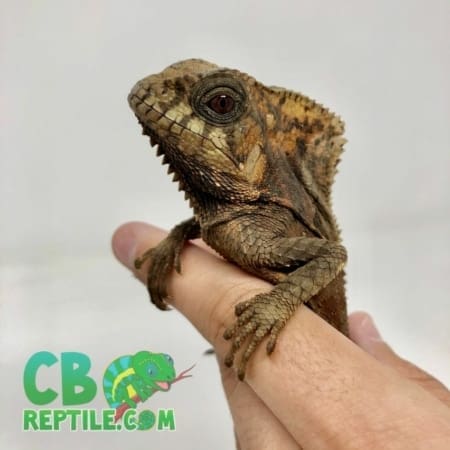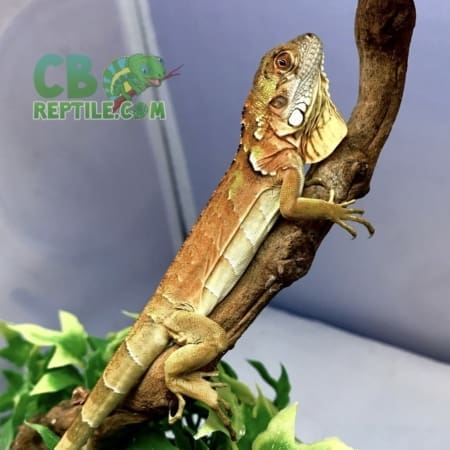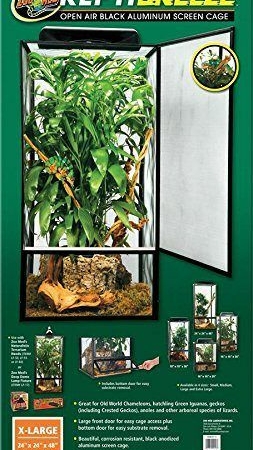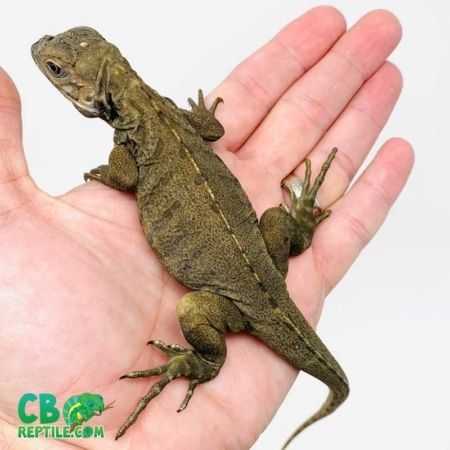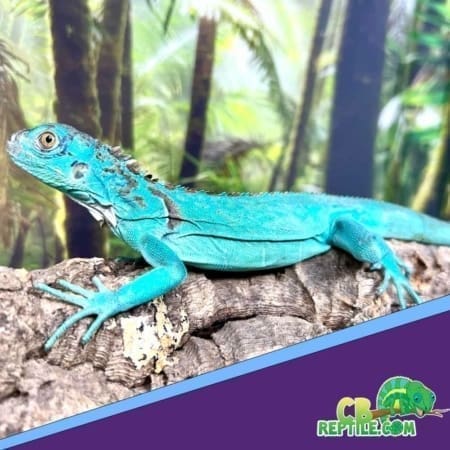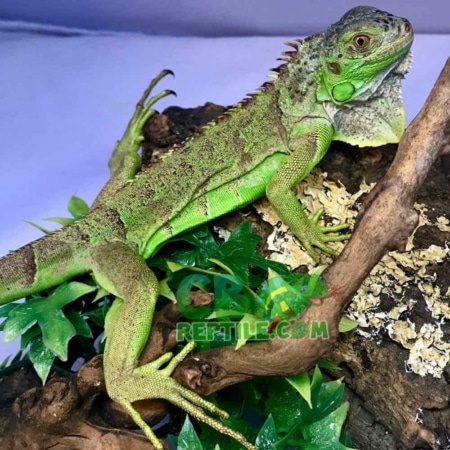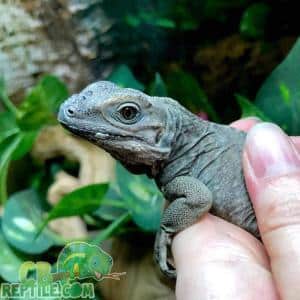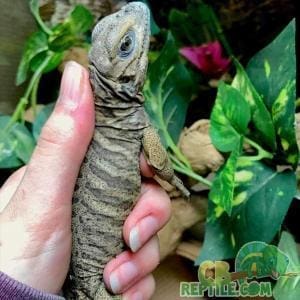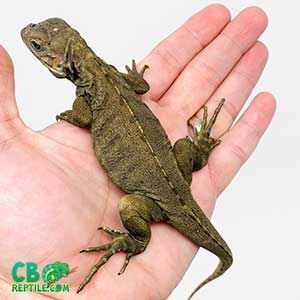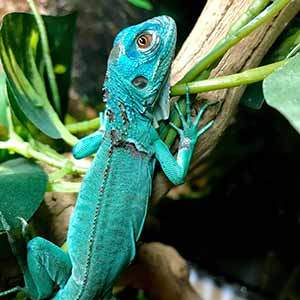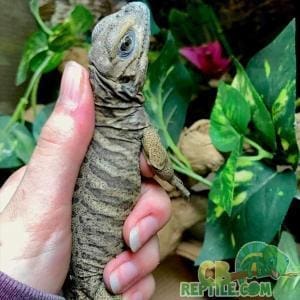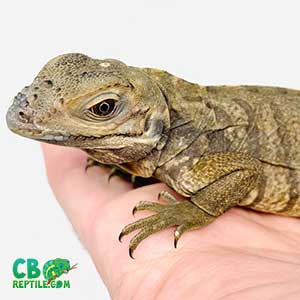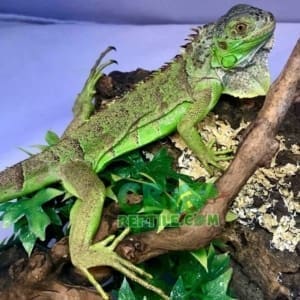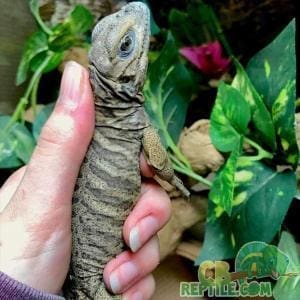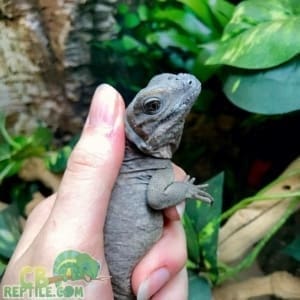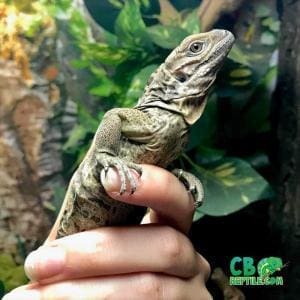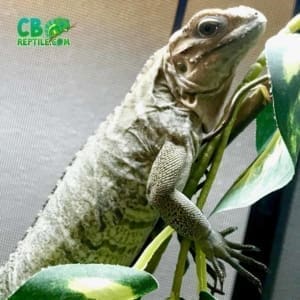Iguana Habitat Temperature
Iguanas for sale, like most reptiles appreciate having a nice temperature gradient to thermoregulate themselves with. The hottest your enclosure should be, at the hot spot, is around 88-90 degrees. The coolest end of the baby or adult Iguana cage would be around 76 degrees so you have a variant of 12-16 degrees from hot to cool end. Providing your baby iguana proper temperatures to grow within will ensure a happy, healthy animal.
Correct iguana habitat temperatures are important!
When deciding what type of lamps, heating elements and wattages to use, just be concerned with the end result (the correct temperatures). For this reason, many different sized lamps and heaters can be used depending on the temperature of the room your baby Iguana for sale is kept in. Some areas may require higher wattage lamps than others based on where you live!
Iguana UVB Lighting
Using the proper type of UVB Lamp for your Rhino iguana is very important no matter what species of iguana. Since pet iguanas enjoy both UVA and UVB when basking in the sun, it is recommended that you use both a Mercury Vapor lamp, to provide an 88-90 degree hot spot. For UVB purposes, it is imperative that you provide the right spectrum of UVB for 10 hours per day. Here at the farm, we use a UVB lamp that is 5.0 or 5% and run it 10 hours per day. Using a T5 high output iguana UVB lamp is recommended over the compact screw in type or MVB. MVB is used in combinations when providing pet Iguana UVB and UVA lighting for the purpose of UVA.
Iguana Care Sheet
Before purchasing your new baby iguana, consider if you are interested in a green iguana for sale, any color of iguana for sale or a blue iguana for sale online. Many places offering an iguana for sale online are offering wild caught specimens and should be avoided at all costs. Be sure to only purchase from a captive bred iguana breeder (like us!)
Iguanas are among the most popular pet reptiles. They love to bask in the sun or under an ultraviolet light, and they enjoy a diet of leafy greens and vegetables. Many people don’t realize that iguanas can grow to be quite large, exceeding 6 ft (1.8 m) in length. Iguanas should be properly socialized when they are young to ensure that they can be handled as adults. They require specialized housing and regular veterinary care and may not be a suitable pet for everyone. This care guide can be used for all species including the Rhino Iguana, Blue Iguana, Green Iguana and Red Iguana.
Our biologist has provided quite a bit of iguana care pages that cover all types of care related topics including:
- Iguana Care Sheet
- Iguanas for sale
- Pet Iguana handling
- Iguana diet
- baby Iguana habitat
- Iguana Lifespan
- Iguana Temperature
- cuban rock iguana
- rock iguana
- blue iguana
- green iguana
- red iguana
- baby iguana
- Rhino Iguana
- blue iguana
- baby iguana
- Rhino Iguana
- pet Iguana for sale
- Iguana Lighting
- Pet Iguana Shedding
- Iguana Size
- Iguana Pictures
- Blue Iguana for sale
- Green Iguana for sale
- Rhino Iguana for sale
Pet Iguana Habitat
Iguana habitats can be made of a variety of things and there are many options. Keep in mind the main concern is if you are doing a permanent habitat, or are you going to continue to redo your habitat as your baby Iguana for sale Grows into a mature adult pet Iguana. Typically, a 4×2′ enclosure works well for the first few years of life. Some keepers use this size for the life of their baby Rhinoceros Iguana for sale, while others only for a few years. Providing your new baby Iguana the opportunity to grow and explore will end with you having a happy, healthy adult Iguana.
Pet Iguanas for sale need to be comfortable. Provide plenty of areas to lay, hide, climb and bask. The stimulation from having many different areas to climb and explore overall is good for your new iguanas mental health. Setting up the proper iguana habitat is a great start to having a long-lived healthy pet iguana for sale.
Pet Iguana Size
All species of iguanas vary in length from 24 to 54 inches. Interestingly, skin colors range from blue grey to a dark green and even brown. The Rhino Iguana name derives from the bony-plated pseudo-horn or outgrowth which resembles the horn of a rhinoceros animal on the Rhino iguana’s snout. Rhino Iguanas weigh anywhere from 3-20 pounds with some variance depending on their specific locale of origin. Blue Iguanas for sale, as well as Green Iguanas and red are all a bit smaller.
Pet Iguana Handling & Iguana Temperament
Handling your baby Iguana as early and as often as possible is key. Here at CB Reptile, our biologist and our reptile care givers handle our Rhinos as often as we can. From hatch day thru the day they leave, our staff works with our baby and big baby iguanas for sale in order to have calm, relaxed pet iguanas for our customers. Experienced iguana breeders should always be chosen when looking to buy the best iguana baby for sale.
When first handling baby Iguanas position them so they cannot squirm out of your hand. Adult iguanas for sale who are not tame should be handled with caution as they can tail whip if frightened. Working with your new pet iguana is the best recipe for success with taming your baby to become a tame adult. Taming baby iguanas is easy, it just requires repetition and commitment from the owner.
Pet Iguana Diet & Iguana Food list
In the wild, most Iguanas eat fruits, vegetables, greens, and insects. Feeding a wide variety of food with proper supplement dusting is key to having a healthy and happy Iggy. Mostly greens like Collard, Mustard Greens as well as Swiss Chard, and other Lettuces can be the staple foods. Vegetables like Squash, Zucchini, etc can also be part of your Rhino Iguanas diet. Avoid foods like spinach, broccoli as they can inhibit proper thyroid function.
Vegetables for your Rhino Iguana
Staple foods can be: Green beans, snap peas, okra, parsnip, yucca root, bell peppers
Occasional foods to be offered: Carrots, beets, sweet potatoes
Rhinoceros Iguana Diet Prep: Chop and then shred vegetables in a food processor if possible.
Squash for a pet Iguana
Staple squashes: Use Acorn, butternut squash, kabocha, pumpkin, spaghetti squash
Less: Banana, delicata, Hubbard, turgan, crookneck and yellow squash
Occasional stuff: Zucchini
Rhino Diet Prep: Skin and remove all of the seeds from all squash items before feeding your baby Rhino Iguana. Using a food processor, grate all squash items so they are soft and shaven.
Fruits for the Iguana
Staples to feed all the time: Figs, dates, even papaya, mango, prickly pear cactus pads as well as the pear cactus fruit
Garnish: Blueberries, raspberries, kiwi, acai berries are also great for them. Also sparingly, feed Apples, bananas, blackberries, pears, cantaloupe, honeydew, watermelon, strawberries, grapes, nectarines
Fruit Prep for your pet iguana:
Using a food processor or very sharp knife, chop all fruit.
Sources for protein: A high-quality, natural adult or juvenile food pellet without color dyes, Mazuri tortoise and Iguana food is best. We use it here at CB Reptile and we have had great success with it. Other options include Zoo Med and OxBow products made for iguanas however we stand by Mazuri.
Iguana Care – Water
Both baby, juvenile and adult Iguanas require fresh, clean water to be available at all times. Water can be provided at all times, in shallow, ramp style water dishes. A lot of the water consumed by the Rhinoceros Iguana is typically from both water itself and food. By feeding greens, that are rich in both vitamins AND water, Rhinos ingest a lot of water while eating fruit and greens. Tap water should sit for at least 36 hours before providing it to your iguana. Chlorine is often in city tap water and dissipates over 24-36 hours to when it is safe for the iguana for sale to drink.
Iguana Humidity
Humidity should be in the area of 65-80% for your pet iguana. Baby iguanas need a higher humid on average versus adults. As your Rhino iguana, it will shed like most reptiles / lizards. Shedding without proper humidity is difficult and can be painful. Losing digits or the edges of digits is possible if the habitat is kept too dry. For these reasons, always consider using a fogger or reptile misting system in order to maintain ambient humidity. Your baby will appreciate your dedication to providing the proper habitat which includes heat, humidity, uv light, structures, and food. When a pet iguana is provided the right humidity, they will shed their skin easily and grow properly. Keeping humidity correct also directly affects the skin quality of the Iguana as well.
Iguana Substrate
Keep in mind that substrate is not recommended anywhere near where you feed your baby Iguana because baby iguanas can ingest tiny pieces of substrate. If this happens, it can lead to the Iguana dealing with intestinal impaction. Substrate options for your Iguana enclosure can be as simple as newspaper, outdoor or reptile carpeting. Basically, try to use products that are easy to clean and replace. Dirt, Soil or stuff like reptile bark, for repti-bark substrates are not recommended for indoor habitats. They can however be used for out door or out side habitats, as long as the feeding area is not covered in substrate.
Iguana Lifespan
Iguanas are fairly long lived lizards. It is believed that in captivity, a baby Iguana for sale can live as long as 30 years! Most consider 20 years an average lifespan for the Iguana. So if you are asking yourself “How long does an Iguana live?” At least 20 years, with good responsible care. Iggies are a long-lived animal and should be treated as such the day they come home.
If you are considering where to buy a Rhino Iguana for sale online, or anywhere, do your research. The lifespan of the baby Iguana for sale will also directly correlated with how he or she was raised. This includes if the Rhino Iguana Breeders handle them and how often. Same goes for any type of blue iguana, green iguana, or red iguana.
Iguana Shedding
Once around a year of age, juvenile iguanas should be shedding every few weeks. They shed so often that sometimes it can appear as if they are constantly in shed for the first two even years of life. Shedding will be in segments and various body parts at different times and this is why humidity is important. As your pet baby iguana grows it will be shedding less often.
Eventually, adult iguanas will shed only once or twice a year and the areas that shed will be larger. For these reasons, It is important to maintain proper humidity. You see, shedding properly really does depend on the air being humid enough to not stick to the animals new skin.
- Display 21 Products per page
-

Cuban Rock Iguana
$469.00 – $679.00Price range: $469.00 through $679.00 Sale!Select options This product has multiple variants. The options may be chosen on the product page -

Helmeted Iguana for sale
$188.00 – $279.00Price range: $188.00 through $279.00 Sale!Select options This product has multiple variants. The options may be chosen on the product page -

Red Iguana for sale
$189.00 – $300.00Price range: $189.00 through $300.00 Sale!Select options This product has multiple variants. The options may be chosen on the product page -
 Rated 5.00 out of 5
Rated 5.00 out of 5Rhino Iguana for sale
$499.00 – $1,959.00Price range: $499.00 through $1,959.00 Sale!Select options This product has multiple variants. The options may be chosen on the product page -
 Rated 5.00 out of 5
Rated 5.00 out of 5Blue Iguana for sale
$295.00 – $325.00Price range: $295.00 through $325.00 Sale!Select options This product has multiple variants. The options may be chosen on the product page -

Green Iguana for sale
$179.95 – $199.95Price range: $179.95 through $199.95 Sale!Select options This product has multiple variants. The options may be chosen on the product page

